Plan checklist
East Mary Street -Megan Smith/Maggie Macdonald/Michelle Gilboard
, Marsh Creek / Picton Bay
Planting plan created by Quinte Conservation
Schedule A:
Plants & Property
Land Characteristics
This planting plan is designed based on the land characteristics identified during the day of the site visit. Plants are chosen according to the soil and light conditions on your property. The number of plants chosen for each planting compartment takes into account the square metre area of the space, as well as the amount of current vegetation cover. Your property is part of ecoZone: 6a
Land Characteristics by Compartment
| Length | Width | Area | pH | Soil | Moisture | Light | Height | |
|---|---|---|---|---|---|---|---|---|
| A | 10m | 5m | 50m2 | normal | sandy, loamy | moist | full sun | |
| B | 10m | 10m | 100m2 | normal | sandy, loamy | moist | full sun | |
| C | 7m | 4m | 28m2 | normal | sandy, loamy | normal, moist | full sun | |
| D | 10m | 2m | 20m2 | normal | loamy | normal, moist | full sun, partial sun | |
| E | 13m | 3m | 39m2 | normal | sandy, loamy | normal, moist | partial sun | |
| F | 15m | 2m | 30m2 | normal | sandy, loamy | normal, moist, wet | full sun, partial sun | |
| G | 0m | 0m | 0m2 | |||||
| H | 0m | 0m | 0m2 | normal | sandy, loamy | normal, moist | full sun | |
| 65m | 3.25m | 267m2 |
Plant Selection Summary
The following shrubs and trees are chosen for their suitability and survivability given the current soil and light conditions in each compartment on your property, as well as preferable features.
| Plant Species | A | B | C | D | E | F | G | H | Potted | Bareroot | Wildflower |
|---|---|---|---|---|---|---|---|---|---|---|---|
| Red Maple | 1 | 1 | 2 | ||||||||
| Gray Dogwood | 1 | 4 | 1 | 4 | |||||||
| Ninebark | 1 | 4 | 1 | 3 | 3 | ||||||
| Balsam Fir | 1 | 2 | 3 | ||||||||
| Allegheny Serviceberry | 1 | 5 | 5 | 2 | 1 | 5 | 9 | ||||
| Black Elderberry | 6 | 1 | 4 | 2 | 1 | 1 | 11 | 4 | |||
| Black Chokeberry | 6 | 1 | 3 | 4 | |||||||
| Nannyberry | 5 | 2 | 3 | ||||||||
| Dense Blazing Star | 3 | 2 | 3 | 8 | |||||||
| Blue Vervain | 3 | 3 | |||||||||
| Green-Headed Coneflower | 3 | 3 | |||||||||
| White Birch | 1 | 1 | |||||||||
| Pussy Willow | 2 | 3 | 1 | 3 | 3 | ||||||
| Silver Maple | 1 | 1 | 2 | ||||||||
| Buttonbush | 1 | 1 | 4 | 2 | 4 | ||||||
| Pasture Rose | 5 | 6 | 11 | ||||||||
| Red Osier Dogwood | 3 | 3 | |||||||||
| Narrow Leaved Meadowsweet | 5 | 4 | 9 | ||||||||
| Fragrant Sumac | 4 | 4 | |||||||||
| Kalm St. Johns Wort | 3 | 3 | |||||||||
| Canada Anemone | 3 | 3 | |||||||||
| Canada plum | 3 | 2 | 2 | 3 | |||||||
| Highbush Cranberry | 1 | 1 | 1 | 3 | |||||||
| Blue Lobelia | 3 | 3 | |||||||||
| Ostrich Fern | 2 | 2 | |||||||||
| Purple Coneflower | 1 | 1 | |||||||||
| Chokecherry | 1 | 1 | |||||||||
| Wild Bergamot | 2 | 2 | |||||||||
| Subtotal | 31 | 30 | 20 | 12 | 12 | 20 | 6 | 5 | 44 | 67 | 25 |
| Totals | 136 | ||||||||||
Plant Information
The following table summarizes key information about each plant selected for your property.
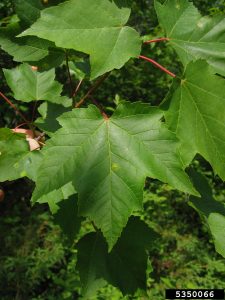
|
Red MapleHeight: 12-25m
The Red Maple is the most common and widespread deciduous tree of Eastern and Central North America. This species can grow 12-25m at maturity. The trunk of this hardwood species is branch free from the base to about halfway up the trunk. When planted in an open area, the trunk can divide and branch out fairly close to the ground. As the tree matures, it develops a short, narrow crown consisting of horizontal and ascending branches. The leaves on the Red Maple grow opposite each other on the branches. During the summer, leaves are bright green on top with a whitish underside. During the fall, the leaves turn a bright red or scarlet colour, from which the name is derived. Prior to leaf development, tree flowers bloom in early May. Red Maple tree flowers are small and red to yellowish orange in colour, growing in clusters on a thin stalk. During June and July, tree flowers develop into reddish winged keys, which hold and disperse seeds. The Red Maple plays an important role in the lumber industry, as its wood is excellent for woodworking.
|
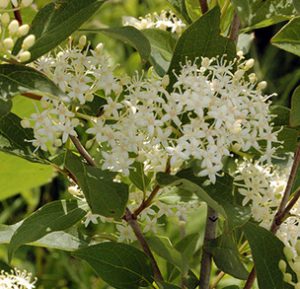
|
Gray DogwoodHeight: 2-3m
The Gray Dogwood, also referred to as Northern Swamp Dogwood or Panicle Dogwood, is a medium-sized, deciduous shrub which typically grows 2-3m. This species is multi-stemmed, with a full, round form. The leaves are green and arranged alternately along the branches. During the fall, leaves turn a bright red to deep purple colour. Between May and June, showy clusters of small white flowers bloom. These flowers turn into white fleshy berries late in the summer. The reddish-pink stems hold the berries throughout the winter, creating an artful contrast to the gray bark and snowy scenery. The Gray Dogwood is tolerant of a variety of environmental conditions and its complex, fibrous root system make it an ideal plant to use for controlling erosion.
|
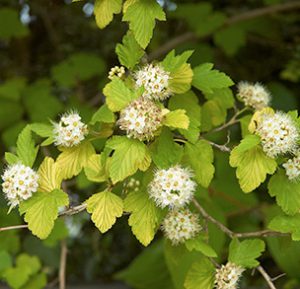
|
NinebarkHeight: 2-3m
The Common Ninebark is a very hardy, large (2-3m in height), deciduous shrub naturally occurring within riparian zones. This species is often planted as an ornamental shrub for its exfoliating bark which reveals reddish-light brown inner bark. This shrub is multi-stemmed with numerous horizontal and ascending branches creating a full, round shape. The Common Ninebark produces dull green, ovate to round shaped leaves with three to five lobes per leaf. During the fall the leaves turn brilliant yellow or dark purple. Between May and June, showy, bell-shaped flowers bloom in clusters on the terminal ends of the branches. During the summer, these flowers give way to small green or green-yellow berries which turn a bright red upon ripening.
|
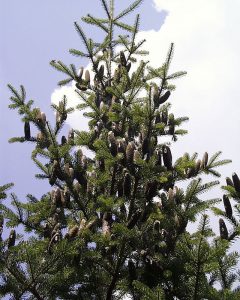
|
Balsam FirHeight: 10-25m
The Balsam Fir is a medium-sized coniferous tree, which can reach heights of 10-25 m. Balsam Fir may also be referred to as Canada Balsam, Eastern Fir, or Bracted Balsam Fir. This species of tree is conical in shape, with resin blisters on older trunks. Balsam Firs produce sticky, dark, upright and erect cones which shed seeds during the fall, while cone structures remain on the tree. Balsam Firs have shallow roots and have been known to blow over easily. This species produces needles which are alternate, flat and narrow. Their dark green needles have rounded or notched tips, two white lines underneath, and are splayed in two ranks on the twig.
|
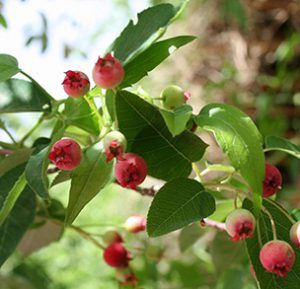
|
Allegheny ServiceberryHeight: 3-10 m
The Allegheny Serviceberry is an attractive deciduous shrub species that can reach about 3 m as a shrub or up to 10 m as a tree. This plant may also be known by the common name Smooth Serviceberry. It can be grown either in the form of a single stem tree or multi-stemmed shrub comprised of two or three smaller trunks. The leaves are dark green, alternately arranged, oval shaped, and have finely toothed margins. The flowers are showy, fragrant, have 5 petals, appear in drooping clusters, and bloom in April before the leaves emerge. The flowers produce small reddish purple to black berries, which are edible and flavorful to humans. The fruit is beneficial to wildlife species, including birds and small mammals. The root system is valuable for controlling erosion and stabilizing loose soil. This plant is often used for ornamental purposes as a small tree in urban areas.
|
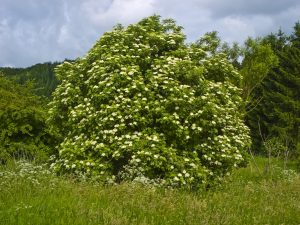
|
Black ElderberryHeight: 4 m
The Black Elderberry is a large, fast-growing, deciduous shrub or small tree, which typically grows to 4m. This species tolerates a variety of conditions and is commonly found in sunny locations with well-drained soils. Black Elderberry can be single or multi-stalked with numerous branches creating a full, round body. Leaves are compound, with 5-7 leaflets that grow opposite each other along the branch. During the fall, leaves tend to turn a pale yellow. During late May to early June, this species produces flowers that are ivory white and grow in flat topped clusters. By late August, flowers turn to glossy, deep purple fruit, which attract a variety of wildlife like songbirds and small mammals. Ripe fruit is edible for humans and is commonly made into jams and jellies. The root system of this species is shallow, and can form colonies through suckering.
|
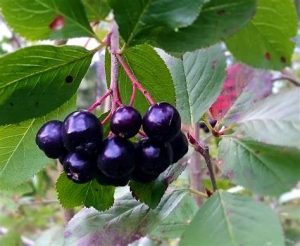
|
Black ChokeberryHeight: 1-3m
The Black Chokeberry is a medium sized deciduous shrub that typically grows between 1-3m with edible fruit. This species requires full sun to partial shade and can tolerate soil conditions from loamy and moist to rocky and dry. Naturally, Black Chokeberry is found in wet wooded areas such as; swamps, along shorelines, and within forest understory. This species is multi-stemmed, and forms thickets from stems which arise from the roots. Leaves are simple, growing alternately along the branch turning a bold red to orange during the fall. During spring, clusters of showy, white flowers appear turning into dark purple berries by fall. This species is resistant to drought, insects, pollution, and disease. The Black Chokeberry is often cultivated as an ornamental plant and food product. Additionally, this species is useful for bank stabilization and erosion control applications.
|
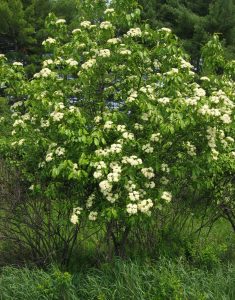
|
NannyberryHeight: 3 m
Nannyberry is a large deciduous shrub species that typically grows about 3 m in height. The leaves are dark green, ovate shaped, oppositely arranged, have a pointed tip, and have finely toothed margins. The flowers are showy, white colored, appear in flat topped clusters, and bloom in May. These flowers produce blueish black berries, which are edible to humans and persist throughout the winter. The flowers are beneficial to pollinator species , like bees and butteries. The fruit is beneficial to wildlife species, including birds and small mammals. This shrub has attractive fall foliage. The root system is extensive, making this plant valuable for controlling erosion and stabilizing loose soil. This shrub can be pruned to have a single stem and grown as a small tree instead of a shrub.
|
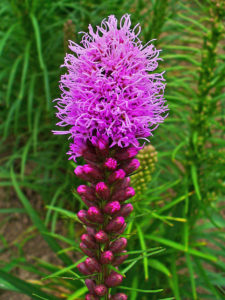
|
Dense Blazing StarHeight: 30-60 cm
Dense Blazing Star is a tall clump-forming perennial wildflower species that can grow between 30 and 60 cm. It has an erect central stem (no branching) that is smooth and purplish/green with many grass-like leaves circulating alternately around it. The leaves are long, narrow, and hairy with one noticeable central vein. This plant is very noticeable when in bloom as it has a wand-like spike of purplish/pink flowers at the top of the central stem. The flowers consist of 4-10 disk florets with a tubular corolla that opens up to 5 spreading star-like lobes and a deeply split protruding style. It prefers moist, well-drained areas such as meadows, moist fields, and along river of lake shorelines. It attracts lots of butterflies and pollinators, as well as mammals such as deer and rabbits. Unfortunately, Dense Blazing Star is listed as threatened under SARA in Ontario. It's main threat is habitat loss due to urban development and habitat alteration. It only naturally occurs in southwestern Ontario with 11-13 known populations. Therefore, this is a great species to plant in suitable areas in Ontario to help protect a threatened species.
|
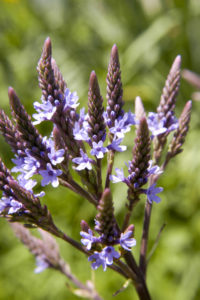
|
Blue VervainHeight: 1.5 m
Blue Vervain is a perennial wildflower species that grows about 1.5 m in height. It has a slender, upright form with reddish-green coloured, rough-haired stems. Its leaves are oppositely arranged, lance-shaped, and on short petioles with large serrations along the edge. Occasionally, there are two lobes present at the base of the leaves. The flowers are showy, blueish purple coloured, have five petals, appear on dense spikes at the top of flowering stems, and bloom between July and September. The flowers bloom first at the bottom of the spike, travelling upwards and blooming in bands. This plant spreads well and can form small colonies. The flowers are beneficial to pollinator species, like bees and butterflies. The seeds are also beneficial to wildlife species, like birds and small mammals.
|
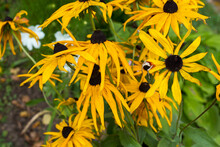
|
Green-Headed ConeflowerHeight: 2.5m
Green-Headed Coneflower is a perennial wildflower that grows from 1-2.5 m in height. The stem is light green, smooth, cylindrical, and branches occasionally. The leaves alternate along the stem and can grow up to 30 cm long and 30 cm wide. The leaf stems are narrow, which gives the leaves a tendency to droop. The lower to middle leaves have 3-7 large lobes and smooth to highly toothed edges. The leaves tend to change in shape depending on how large they grow; but are usually elliptic to ovate in shape. The uppermost leaves on the flowering stalks are much smaller in size and lanceolate to ovate in shape without lobes. The upper leaf surface is dark green and hairless while the lower leaf surface is pale-medium green and sparingly hairy. The stems terminate with clusters of yellow flowers that each have their own stalk up to 5 cm in length. The flowers are 5-8 cm across and have a round center with 6 to 12 yellow petals. The central cone is light green while immature, but it later changes to a yellow colour, resembling a pincushion because of its tubular disk florets that all come out of the cone. Each disk floret is replaced by a 3-4.5 mm, hard, oblong shaped seed pod that has a crown of tiny blunt teeth at its apex. Green-Headed Coneflower prefers moist soils and partial sun. It can be found growing naturally in wet open forests, moist meadows, forest edges, moist thickets, river banks, lake shorelines, and pastures. This wildflower is tolerant of slow-draining, clay-heavy soils. The root system is fibrous and forms clusters that spread through underground rhizomes, which makes this plant great for erosion control, as it will spread and stabilize the soil. Many pollinators are attracted to the Green-Headed Coneflower including bees, wasps, butterflies, skippers, moths, and various kinds of flies. Several insects and animals use the plant for food, including Golden Glow Aphids, Silvery Checkerspot Butterflies, Tortricid Moths, Wavy-Lined Emerald Moth, and Common Pug Moth. Additionally, some bird species like Common Goldfinches feed on the seeds of Green-Headed Coneflower.
|
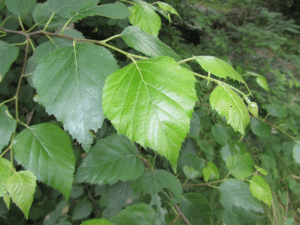
|
White BirchHeight: 15-25m
The Paper Birch is a medium-sized (15-25m), deciduous tree which may also be referred to as White Birch or Canoe Birch. This species produces a sparse, irregular crown which arises from a slender trunk. This tree is best known for distinctive white, horizontally flaking bark, from which its name is derived. The Paper Birch produces light green, egg-shaped, 5-10 cm long leaves alternately arranged. During the fall, the light green foliage turns a bright yellow colour. During the spring, catkins appear and produce winged seed keys which mature and drop between the fall and following spring.
|
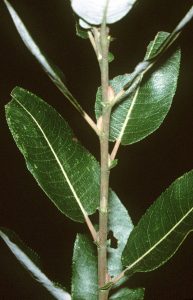
|
Pussy WillowHeight: 6m
The Pussy Willow is a fast growing, deciduous shrub or small tree found reaching heights of 6m, and is from British Columbia to Newfoundland. This species grows from shoots extending from the base of the trunk, creating a multi-stemmed, tall, round bush. The Pussy Willow is an ideal species for bank stabilization and erosion control due to its large, fibrous root system and love of water. This species branches extend from the main shoots and are usually hairy and reddish-brown in colour. The main shoots of Pussy Willow are smooth and greyish-brown, becoming scaly with age. It produces simple, narrow, lance-shaped leaves alternately arranged along the branch. The Pussy Willow yields purple-brown fuzzy catkins which will form long-beaked and finely haired capsules during May and June.
|
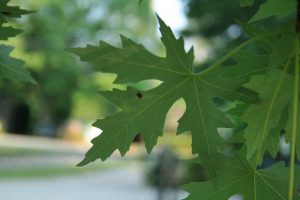
|
Silver MapleHeight: 30m
The Silver Maple is a fast growing, deciduous Maple tree famous for its majestic, mature form. This species has a broad, round crown that sits on top of a tall straight trunk reaching 30m in height. Its ascending branches give this tree a full, bushy appearance. Silver Maple leaves can be differentiated from other Maple leaves due to the deep notches on their lobes. It has a silvery white colour on its underside in contrast to bright, light green topside. During the fall, the leaves on the Silver Maple turn a reddish orange to bright golden yellow. Between late April and May, inconspicuous, small greenish red flowers bloom and by June turn to yellowish-green or brownish pairs of winged keys. The Silver Maple's shallow, spreading root system and ability to withstand flood and drought make it an excellent tree to utilize for erosion control and shoreline stabilization.
|
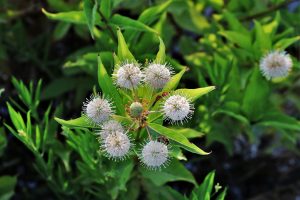
|
ButtonbushHeight: 2 m
Buttonbush is a small to medium-sized deciduous shrub species which typically grows about 2 m in height. This plant may also be known by the common name Button Willow. Twigs are slender to stout and dark red-brown in colour with white speckling. The leaves are bright green coloured, shiny, ovate shaped, oppositely arranged, and have entire margins. The flowers are tiny, tubular, white, fragrant, and appear densely on distinctive, spherical clusters in June. These flowers turn into a dense cluster of seeds, which remain on the plant throughout the winter. The flowers are beneficial for pollinator species, including hummingbirds and butterflies. This is a hardy, adaptable species and an excellent choice for planting on wet shoreline sites.
|
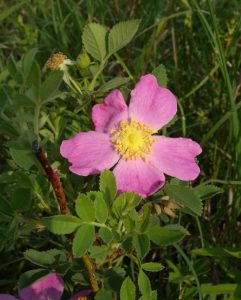
|
Pasture RoseHeight: 1.5 m
The Pasture Rose is a small (1.5m), deciduous shrub which often spreads through suckers to form colonies or thickets in the wild. This species grows erect from a central base with sprawling branches, creating a dense, irregular bush. This shrub produces compound leaves, consisting of 5 to 7 leaflets arranged alternately along the branches. The Pasture Rose yields beautiful 5 centimeter wide white to pink flowers, which bloom in the early summer lasting for approximately a month. The rose hip fruit develops after the flower has died and turns bright red as it ripens. During the fall, the olive green leaves turn yellow to deep red or purple.
|
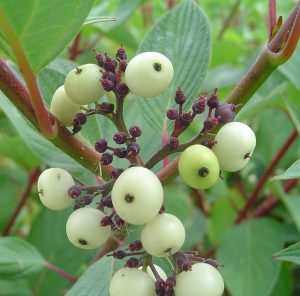
|
Red Osier DogwoodHeight: 1.5-4m
The Red Osier Dogwood is a medium-sized, deciduous shrub native throughout Northern and Western North America which typically grows to 1.5-4m. This species is multi-stemmed with numerous erect and ascending bright red branches that create a loose and spreading form. Leaves produced are simple, two-toned with a dark green upper side and light green underside. They are arranged opposite each other along the branches. During the fall, the foliage turns a brilliant red to dark purple. Clusters of small, creamy white flowers form on the terminal ends of the branches between June and July. The Red Osier Dogwood produces blueish-white fruiting bodies during late summer, which may persist throughout the winter. This shrub's berries provide an important winter food source for numerous species, from large deer to small wintering birds.
|
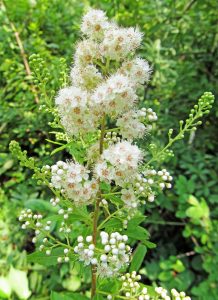
|
Narrow Leaved MeadowsweetHeight: 1-2m
The Narrow Leaved Meadowsweet is an erect, deciduous shrub, which grows in the shape of a mound to a height of 1-2m. This species develops numerous branches and branchlets, giving it a sparse appearance. Leaves produced are simple and narrow with sharply toothed borders growing alternately along the branches. These bright, light green leaves appear crowded, as they grow close together on the stocks and branches. During the fall, leaves turn a yellow-red or yellow-orange colour. Small white to light pink flower clusters appear in the spring growing in a dense, narrow pyramid at the terminal ends of the branches. During late summer to early fall, these flowers produce smooth, papery seed pods.
|
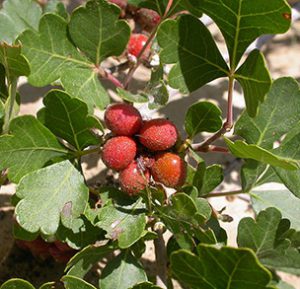
|
Fragrant SumacHeight: 1-2m
The Fragrant Sumac is a medium-sized deciduous shrub within the Cashew family. This species grows between 1-2 meters in height, is multi-stemmed, and produces a round, dense crown composed of erect and spreading branches. Between March and April, small yellow flower clusters bloom on the terminal ends of the branches prior to leaf development. Fruit development begins during late summer. Small, red, hairy berries are produced and can remain on the plant throughout the winter. Male catkins develop on the plant in September. Fragrant Sumac leaves are simple and arranged alternately along the branch. Leaves produced are simple and trifoliate with a large center lobe, appearing similar to Poison Ivy. During the spring and summer, the leaves are light green to green-yellow in colour turning a bright yellow to red or dark purple in autumn. Crushed leaves and stems of the Fragrant Sumac produce a fragrant citrus aroma, hence the common name. The aroma of this shrub is attractive to butterfly species, making it the perfect addition to any butterfly garden. The roots of the Fragrant Sumac are shallow, fibrous, and spread rapidly, making it an ideal choice for stabilizing shorelines and mitigating erosion on steep slopes. Unlike other Sumac species, Fragrant Sumac is significantly less aggressive and easily maintained.
|
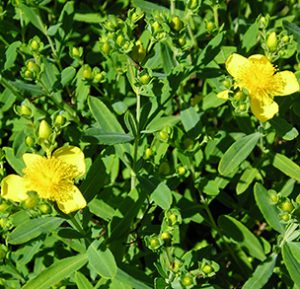
|
Kalm St. Johns WortHeight: 1 m
Kalm St. Johns Wort is a short, evergreen shrub species that typically grows less than 1 m in height. Older bark is reddish brown and appears shedding. The leaves are bluish green colored, narrow and linear shaped, appear in oppositely arranged pairs, and have entire margins. The flowers are showy, golden yellow colored, have five petals, numerous stamens, appear on upper branching stems, and bloom between July and August. These flowers produce small brown oval seed capsules. The flowers are beneficial for pollinator species, like bees and butterflies. These shrubs are visually attractive and used for making low hedges.
|
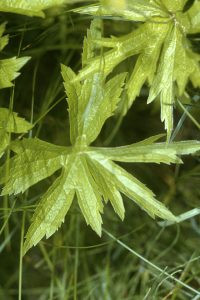
|
Canada AnemoneHeight: 50 cm
Canada Anemone is a perennial wildflower species that typically grows about 50 cm tall. This plant may also be known by the common names Meadow Anemone or Roundleaf Anemone. The leaves are basal, dark green, deeply divided into 3-5 lobes with 2-3 sub-lobes, have prominent veins, and have toothed margins. The flowers are showy, white colored, have 5 petal-like sepals, have yellow center stamens, appear on erect hairy stems, and bloom between April and June. After blooming, the flowers are replaced by a cluster of achenes that are 4-6 mm in size, hairy, and slightly flattened. These wildflowers are tolerant of juglone, a toxic compound that is naturally produced by plants in the Walnut family, like Walnut, Pecan, and Hickory trees. This wildflower is beneficial for pollinator species, like bees and butterflies. This plant spreads quickly through rhizomes and can be valuable for re-vegetating large areas as a ground cover.
|
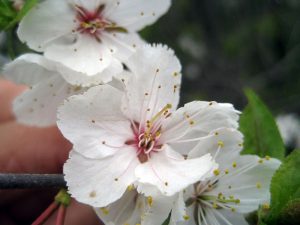
|
Canada plumHeight: 6-10 m
Canada Plum is a small tree or large shrub that grows to about 6-10 m in height. Canada Plum may also be referred to as Red Plum, Black Plum, Wild Plum, or Horse Plum. The bark is reddish-brown to black when young and greyish-brown and peeling with age. The branches contain several spines that are about 5 cm long. The leaves are deciduous, alternate, dull green in colour, broadly oval shaped, and are double toothed along the margins. Canada Plum flowers are showy, appear in clusters of 2-4, white to pale pink with 5 petals, and bloom in late April to early June before the leaves emerge. The fruit is an edible red or yellow plum that is 2.5-3 cm long and ripens between August and September. The plums can be eaten fresh or used in jams and jellies, but caution should be taken, as all parts of the tree except the skin and flesh are toxic. Several species of mammals and birds feed on the plums and the flowers attract bumblebees.
|
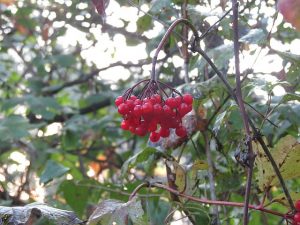
|
Highbush CranberryHeight: 3 m
Highbush Cranberry is a large deciduous shrub species that typically grows about 3 m in height. The branches on this shrub are dense with arching stems, creating a full form. The leaves are oppositely arranged, Maple leaf shaped, have 3 lobes, and have entire or toothed margins. The flowers are showy, creamy white coloured, appear in flat clusters with larger florets surrounding smaller ones, and bloom between May and June. These flowers change into drooping, bright red berry clusters that persist throughout the winter. While the berries are edible to humans, they are very tart when consumed raw so are typically cooked first. This shrub has very attractive fall foliage, changing a reddish purple colour. The flowers are beneficial to pollinator species, like bees and butterflies. The fruit is beneficial to wildlife species, including birds and small mammals. The root system is extensive, making this shrub valuable for controlling erosion and stabilizing loose soil. This species can be found across Canada from Newfoundland to British Columbia, but is most commonly found in Ontario and Quebec.
|
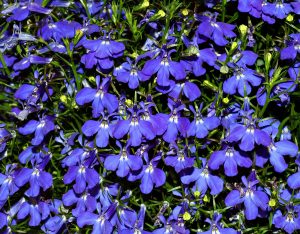
|
Blue LobeliaHeight: 1 m
Blue Lobelia is a wildflower species that can grow up to 1 m in height. This plant may also be known by the common name Blue Cardinal Flower. The leaves are light green coloured, alternately arranged, ovate shaped, and have finely toothed margins. The flowers are attractive and showy, light to dark blue in colour with white patches, have two lips, with the upper lip having two lobes that curl backward and the lower lip having three lance shaped lobes that point downward, appear in dense clusters on tall racemes, and bloom between July and September. The flowers are beneficial to pollinator species, like bees and butterflies. The seeds are also beneficial to wildlife species, like birds and small mammals.
|
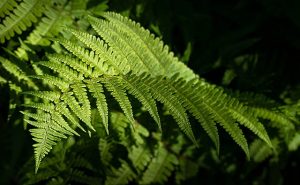
|
Ostrich FernHeight: 1.5 m
The Ostrich Fern is a coarse, erect to arching perennial fern, that can grow up to 1.5 m in height. The stems are clustered and arching while the leaves are ostrich-plume shaped, widest near top, and very gradually narrowed to the base. The size of the leaves grow up to 1.5 m long and 12-40 cm wide, with around 40 pairs of leaflets or pinnae. The leaflets are long, narrow-pointed, and ascending. The leaves are fertile, with spore clusters on the undersides of sub-leaflets.
|
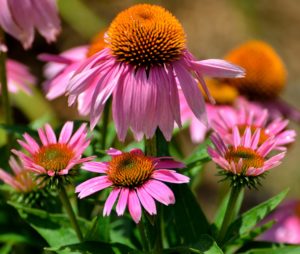
|
Purple ConeflowerHeight: 1m
Purple Coneflower is a perennial wildflower that typically grows about 1 m tall. This plant may also be known by the common name Echinacea. The leaves are dark green coloured, alternately arranged, lance shaped with pointed tips, and have serrated margins. The flowers are showy, pale purple to pink, have 15-20 toothed petals, appear atop erect stems, and bloom between June and August. This wildflower spreads well and can be used to naturalize un-vegetated areas. The roots can be useful for controlling erosion and stabilizing shorelines. This flower blooms for long periods. The flowers are beneficial to pollinator species, like bees and butterflies. The seeds are also beneficial to wildlife species, like birds and small mammals.
|
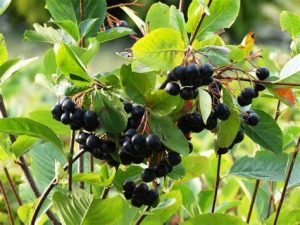
|
ChokecherryHeight: 6-9 m
The Chokecherry is a large deciduous shrub or small tree which grows between 6 and 9 m tall and is a member of the Rose family. It produces a twisted or crooked trunk as well as a narrow, oval to round crown composed of many slender branches. Leaves are alternately arranged, simple, have a deep green upper surface, and light matte green undersides with tufts of hair at the vein axils. During the fall, foliage turns a vibrant deep red to fire yellow or orange. Between May and June, small showy white flowers grow in cylindrical clusters on the terminal ends of branches. By mid-August, flowers turn into shiny deep red or black cherries, which hang in elongated clusters. The fruit is ripe by September and provides a food source for birds and small mammals. The Chokecherry is often found as pure stands forming thickets, or mixed with other early succession shrub and tree species. This fast-growing plant can quickly invade logged land, abandoned farms, and exposed shorelines. The fibrous and wide-spreading root system of this shrub make it an ideal plant for erosion control and bank stabilization. This species possesses the ability to withstand moderate flooding and drought.
|
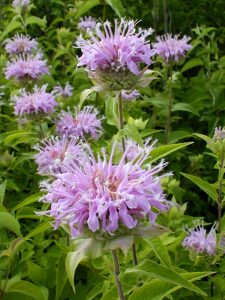
|
Wild BergamotHeight: 1 m
Wild Bergamot is a perennial wildflower species that is member of the mint family and can grow about 1 m tall. Its stems are light green and smooth with abundant branching on the upper half. The leaves are oppositely arranged, broadly lanceolate shaped, 6-10 cm long, and have toothed edges. The also leaves emit a aromatic minty/oregano scent when crushed. The flowers are showy, pink/lavender coloured, appear on the ends of flowering stems, and bloom between July and September. The flowers bloom in the center of the head first, moving outwards creating a wreath. The flowers are beneficial to pollinator species, like bees and butterflies. This wildflower spreads well and can be used to naturalize un-vegetated areas. The roots can be useful for controlling erosion and stabilizing shorelines.
|
Compartment A
Naturalization Area
See attached for species considers. High shrubs to block views and create privacy. pH: normal
pH: normal Depth: bareroot
Depth: bareroot-
 Moisture: moist
Moisture: moist -
 Soil Type: sandy, loamy
Soil Type: sandy, loamy -
 Light conditions: full sun
Light conditions: full sun
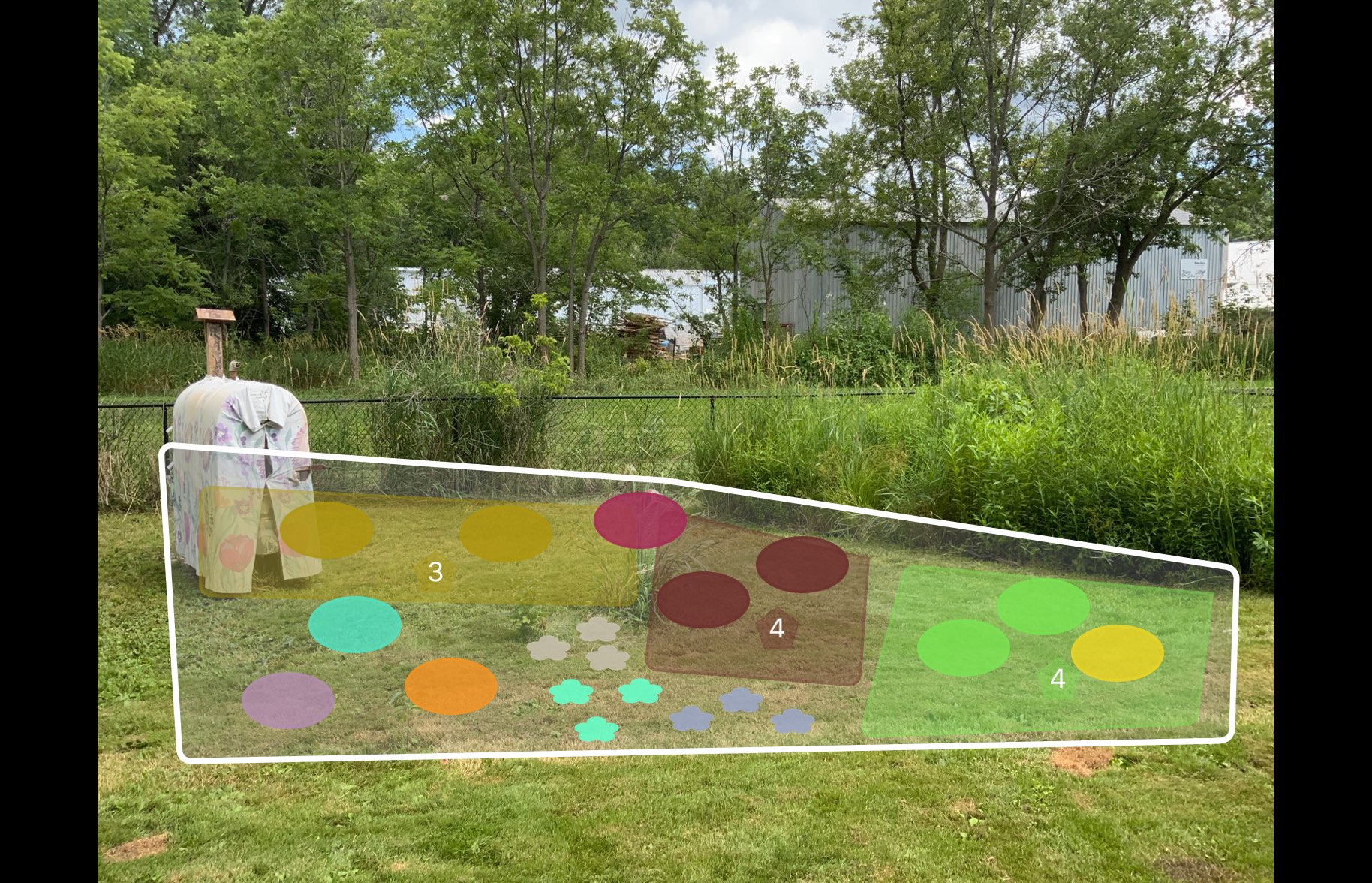
Compartment B
Naturalization Area
White spruce and or balsam fir (3). Roses and service berry to be planted on outside of the fence. Maintain some views towards the gate. pH: normal
pH: normal Depth: potted, bareroot
Depth: potted, bareroot-
 Moisture: moist
Moisture: moist -
 Soil Type: sandy, loamy
Soil Type: sandy, loamy -
 Light conditions: full sun
Light conditions: full sun
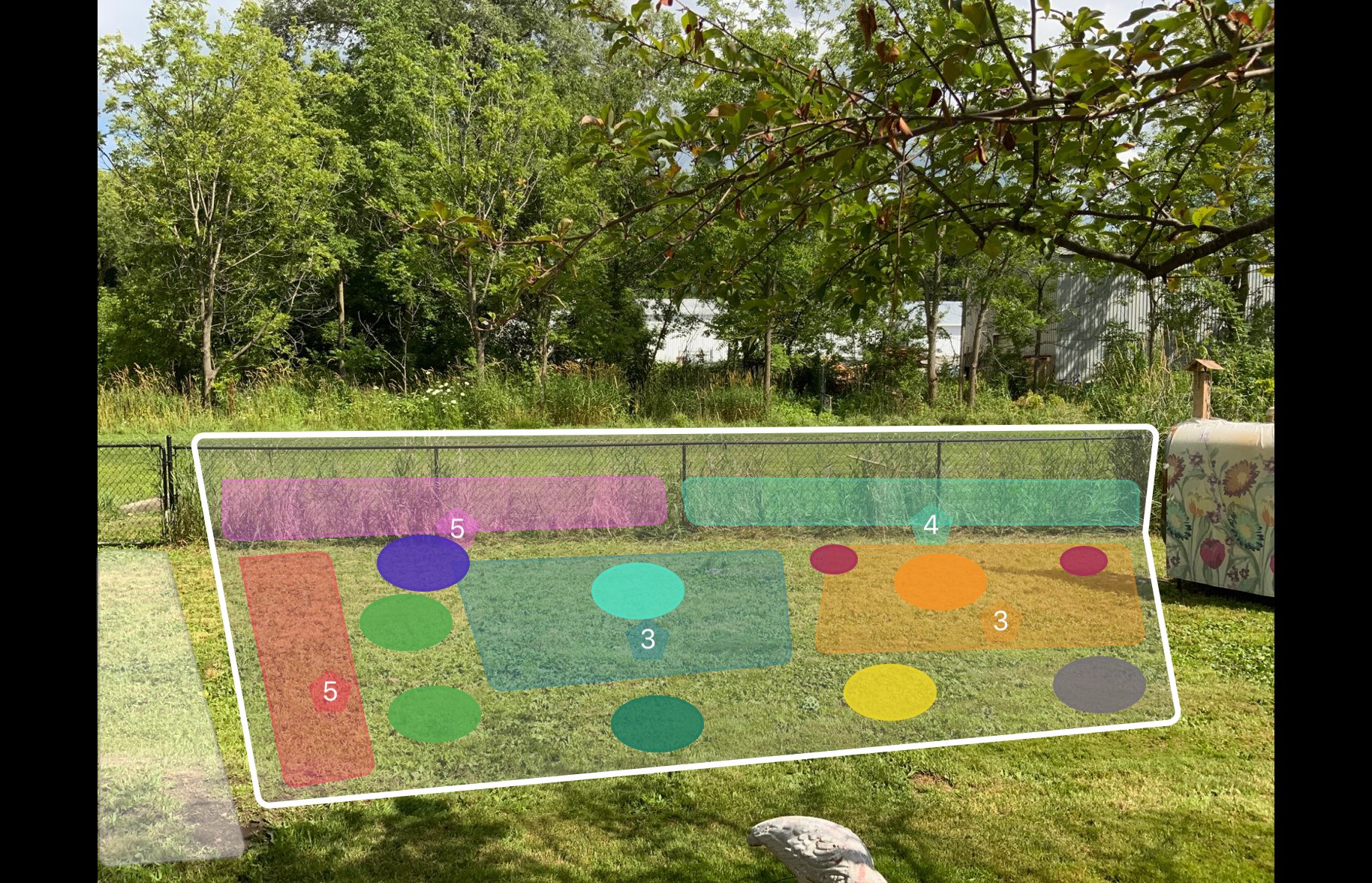
Compartment C
Naturalization Area
Shrubs under the cotton wood. Red osier dogwood died, silver maple, black elder berry pH: normal
pH: normal Depth: potted, bareroot
Depth: potted, bareroot-
 Moisture: normal, moist
Moisture: normal, moist -
 Soil Type: sandy, loamy
Soil Type: sandy, loamy -
 Light conditions: full sun
Light conditions: full sun
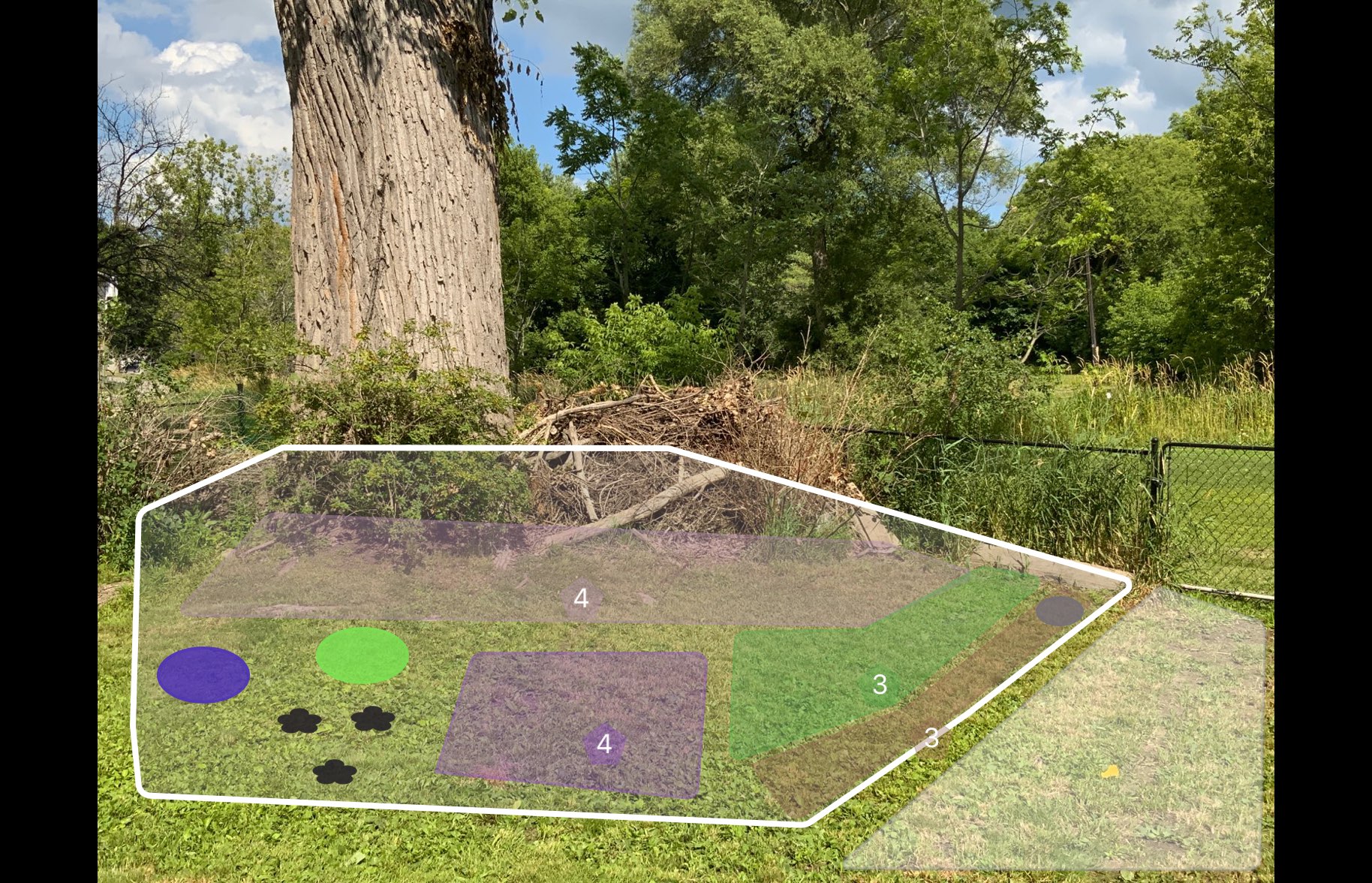
Compartment D
Naturalization Area
 pH: normal
pH: normal Depth: bareroot
Depth: bareroot-
 Moisture: normal, moist
Moisture: normal, moist -
 Soil Type: loamy
Soil Type: loamy -
 Light conditions: full sun, partial sun
Light conditions: full sun, partial sun
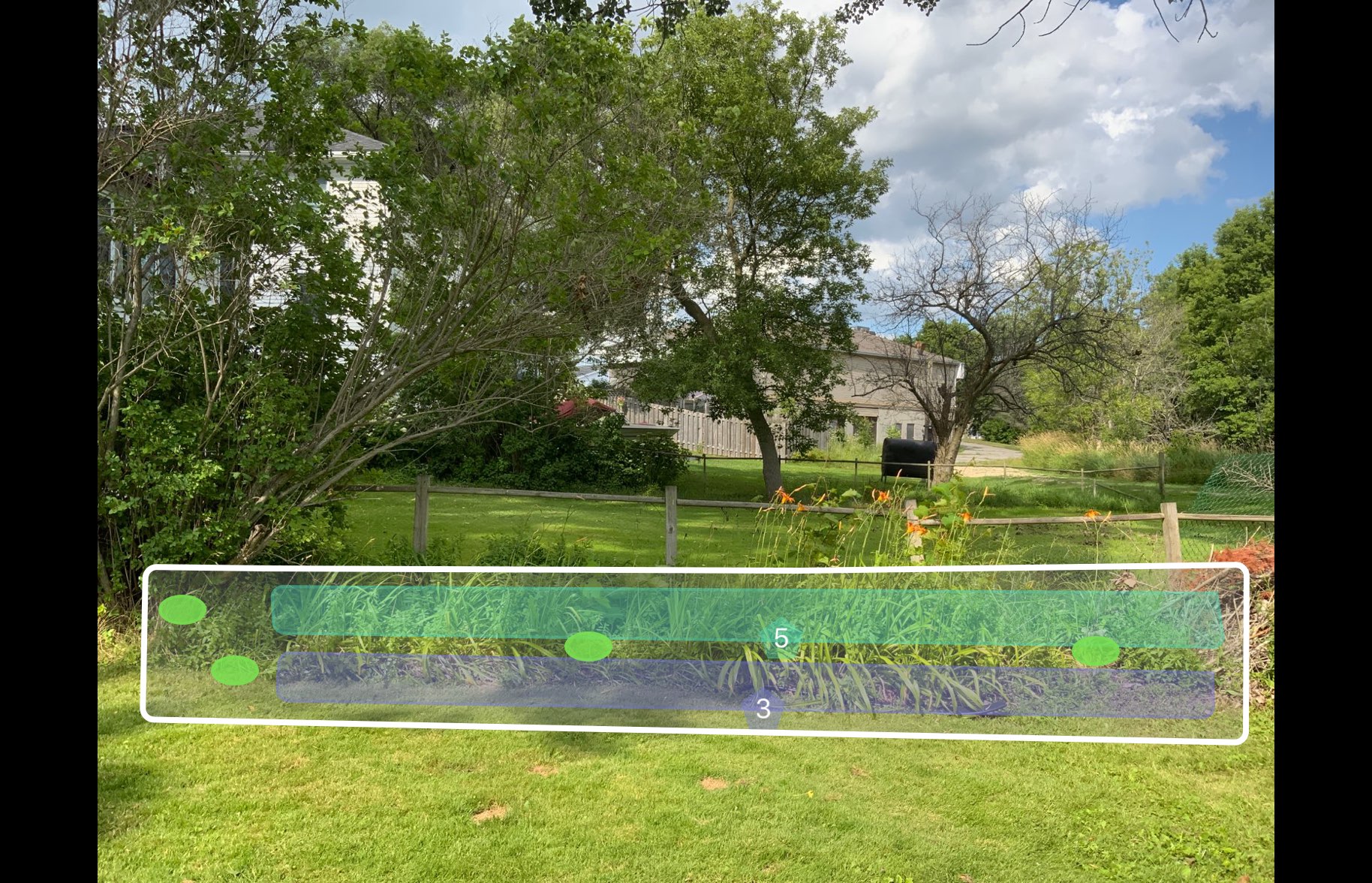
Compartment E
Naturalization Area
5 East Mary St, owner is Maggie MacDonald. Will need to sign separate landowner agreement. pH: normal
pH: normal-
 Moisture: normal, moist
Moisture: normal, moist -
 Soil Type: sandy, loamy
Soil Type: sandy, loamy -
 Light conditions: partial sun
Light conditions: partial sun
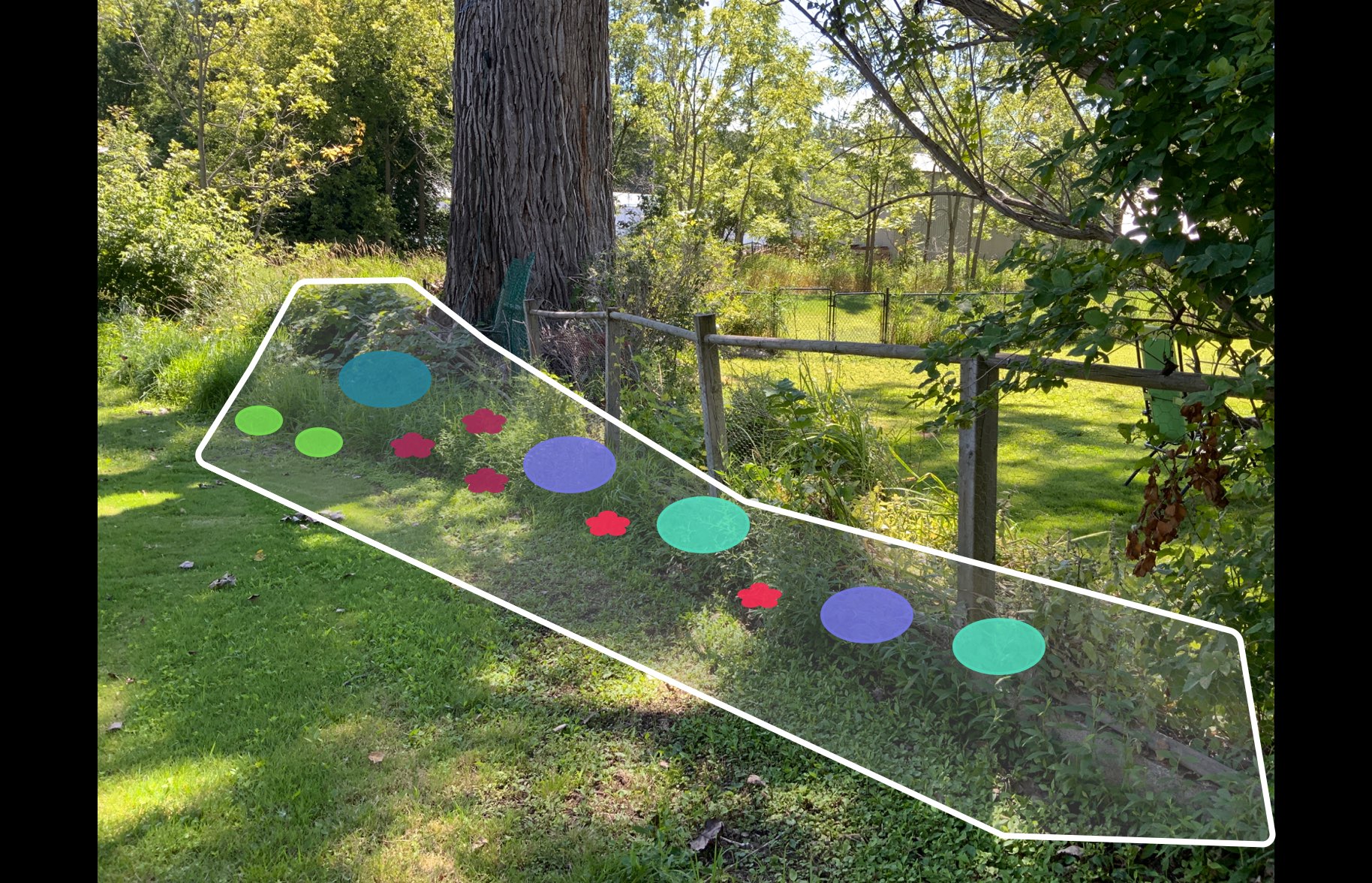
Compartment F
Naturalization Area
5 east Mary street , M. macdonald pH: normal
pH: normal-
 Moisture: normal, moist, wet
Moisture: normal, moist, wet -
 Soil Type: sandy, loamy
Soil Type: sandy, loamy -
 Light conditions: full sun, partial sun
Light conditions: full sun, partial sun
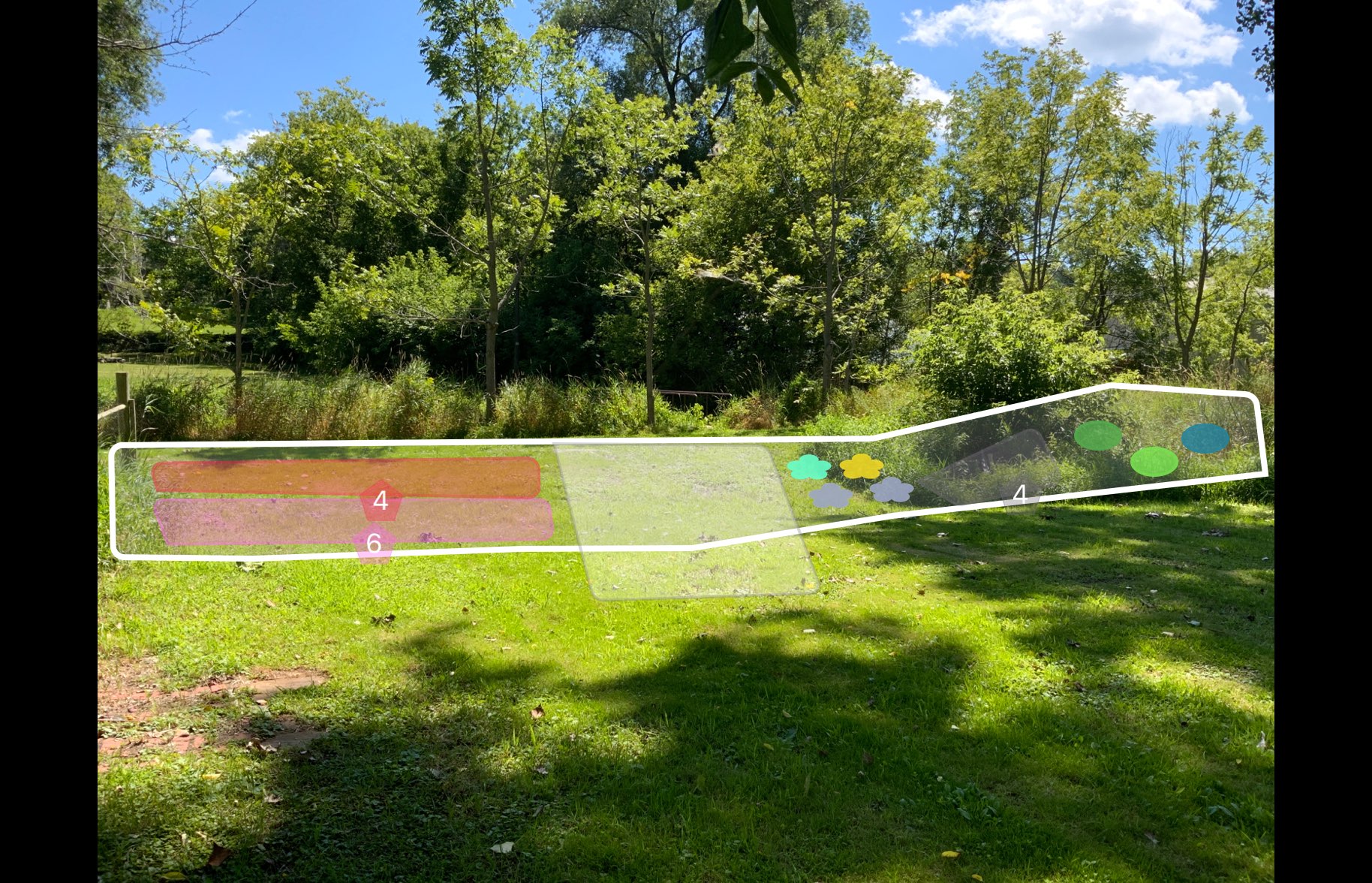
Compartment G
Naturalization Area
1 East Mary street - Landowner is M Gilboard.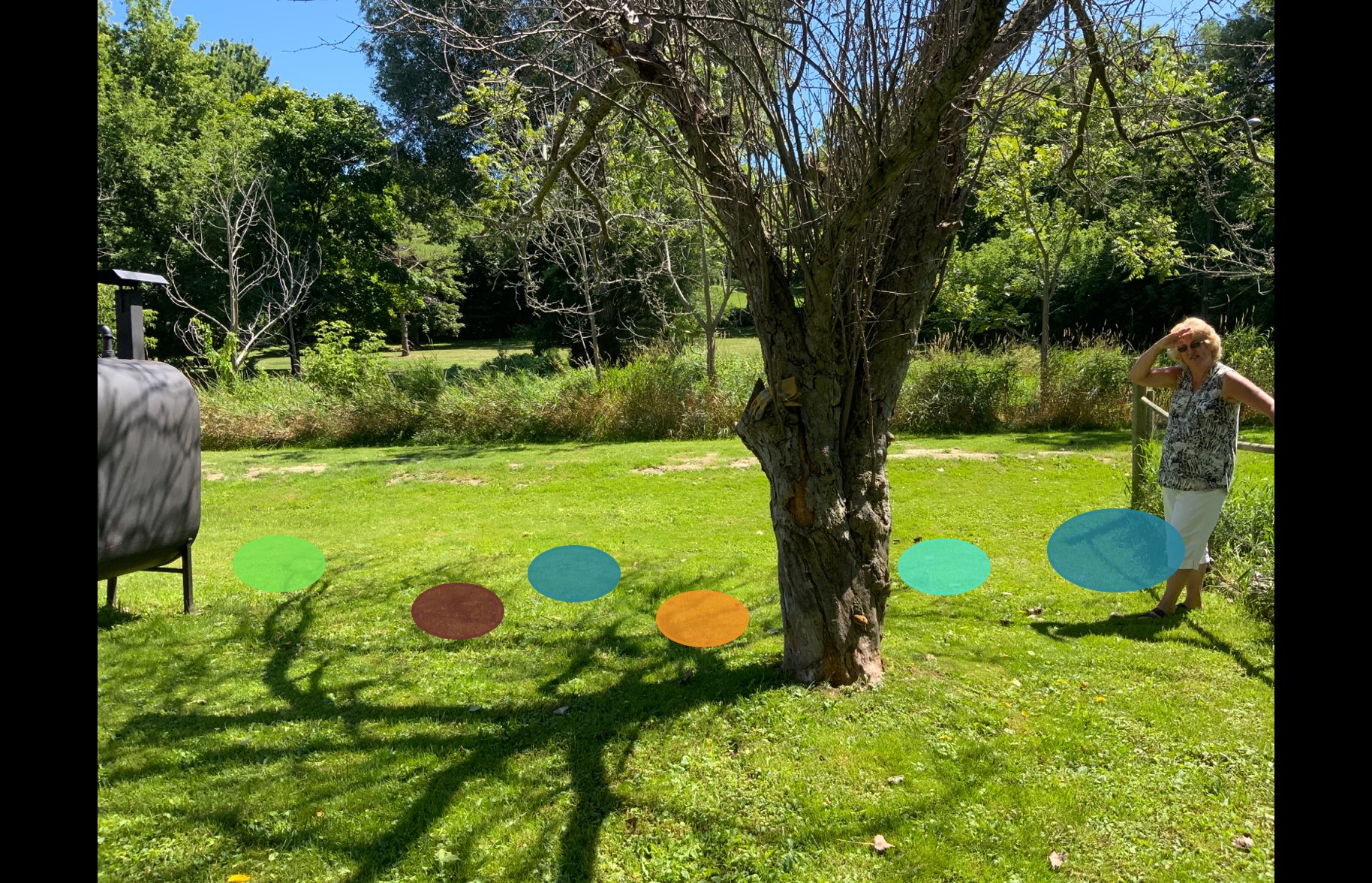
Compartment H
Naturalization Area
Landowner is M Gilboard. pH: normal
pH: normal-
 Moisture: normal, moist
Moisture: normal, moist -
 Soil Type: sandy, loamy
Soil Type: sandy, loamy -
 Light conditions: full sun
Light conditions: full sun
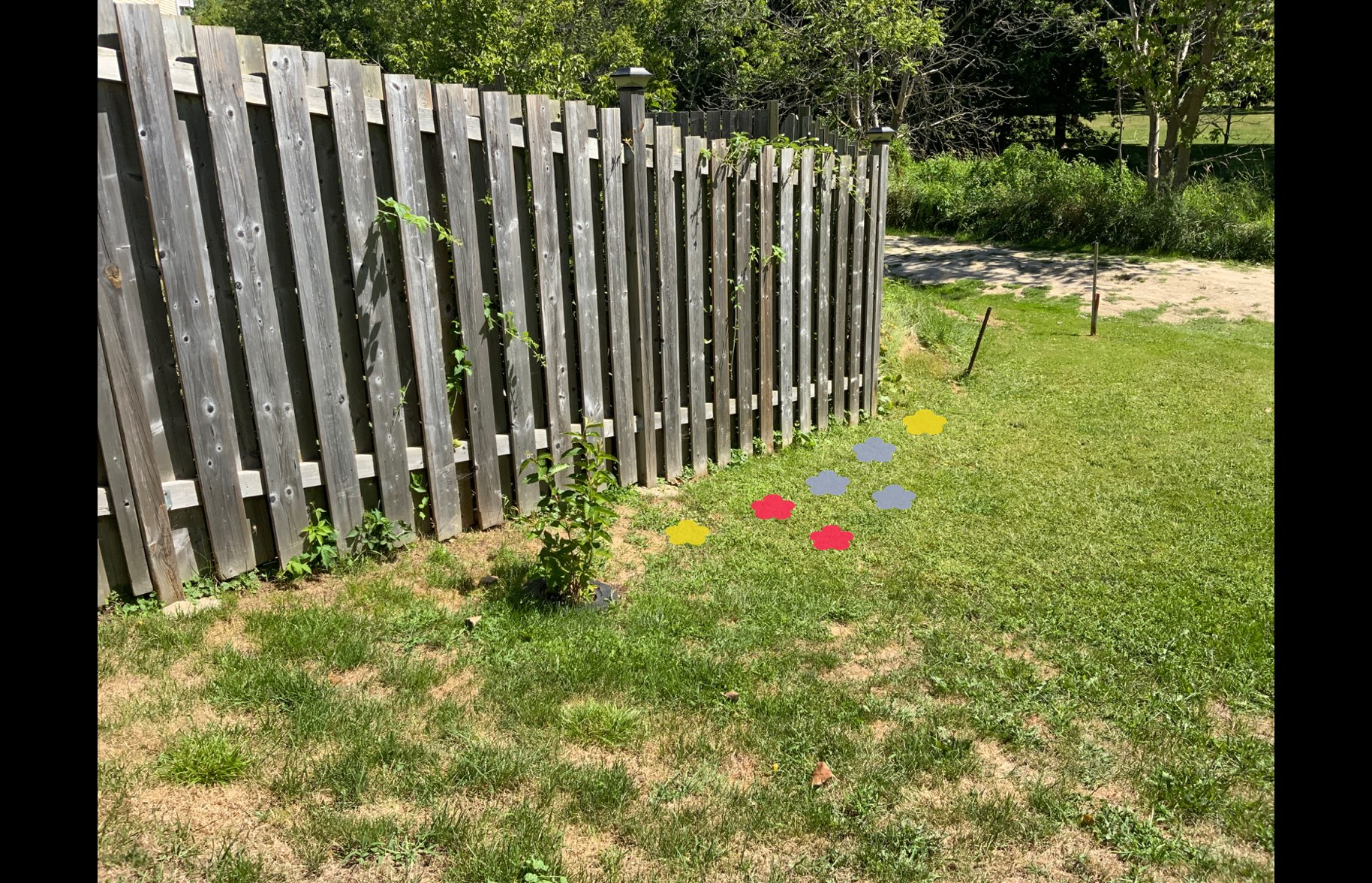
Schedule B
Financial Summary
Project by: Quinte Conservation
The following section outlines the total cost of your project. It has been divided into 2 sections; 1- Plants and Material, 2- Services. It also includes the breakdown of the landowner contribution and the portion that will be paid by Watersheds Canada, as outlined in the Project Costs Total table.
The Natural Edge program has received generous funding to help support the costs of plants, materials, and project coordination and delivery, making this program possible.
Potted stock |
|||
| Item | Quantity | Cost/Item | Subtotal |
|---|---|---|---|
| Red Maple | 2 | 15.45 | 30.90 |
| Gray Dogwood | 1 | 15.45 | 15.45 |
| Ninebark | 3 | 15.45 | 46.35 |
| Balsam Fir | 3 | 15.45 | 46.35 |
| Allegheny Serviceberry | 5 | 15.45 | 77.25 |
| Black Elderberry | 11 | 15.45 | 169.95 |
| Black Chokeberry | 3 | 15.45 | 46.35 |
| Nannyberry | 2 | 15.45 | 30.90 |
| White Birch | 1 | 15.45 | 15.45 |
| Pussy Willow | 3 | 15.45 | 46.35 |
| Silver Maple | 2 | 15.45 | 30.90 |
| Buttonbush | 2 | 15.45 | 30.90 |
| Canada plum | 2 | 15.45 | 30.90 |
| Highbush Cranberry | 3 | 15.45 | 46.35 |
| Chokecherry | 1 | 15.45 | 15.45 |
| Total Potted plant stock | 44 | 679.80 | |
Bareroot stock |
|||
| Item | Quantity | Cost/Item | Subtotal |
| Gray Dogwood | 4 | 2.58 | 10.32 |
| Ninebark | 3 | 2.58 | 7.74 |
| Allegheny Serviceberry | 9 | 2.58 | 23.22 |
| Black Elderberry | 4 | 2.58 | 10.32 |
| Black Chokeberry | 4 | 2.58 | 10.32 |
| Nannyberry | 3 | 2.58 | 7.74 |
| Pussy Willow | 3 | 2.58 | 7.74 |
| Buttonbush | 4 | 2.58 | 10.32 |
| Pasture Rose | 11 | 2.58 | 28.38 |
| Red Osier Dogwood | 3 | 2.58 | 7.74 |
| Narrow Leaved Meadowsweet | 9 | 2.58 | 23.22 |
| Fragrant Sumac | 4 | 2.58 | 10.32 |
| Kalm St. Johns Wort | 3 | 2.58 | 7.74 |
| Canada plum | 3 | 2.58 | 7.74 |
| Total Bareroot plant stock | 67 | 172.86 | |
Wildflower stock |
|||
| Item | Quantity | Cost/Item | Subtotal |
| Dense Blazing Star | 8 | 5.15 | 41.20 |
| Blue Vervain | 3 | 5.15 | 15.45 |
| Green-Headed Coneflower | 3 | 5.15 | 15.45 |
| Canada Anemone | 3 | 5.15 | 15.45 |
| Blue Lobelia | 3 | 5.15 | 15.45 |
| Ostrich Fern | 2 | 5.15 | 10.30 |
| Purple Coneflower | 1 | 5.15 | 5.15 |
| Wild Bergamot | 2 | 5.15 | 10.30 |
| Total Wildflowers plant stock | 25 | 128.75 |
Tending materials |
|||
| Item | Quantity | Cost/Item | Subtotal |
|---|---|---|---|
| Mulch | 136 | 1.55 | 210.80 |
| Tree guards (deciduous only) | 10 | 1.50 | 15.00 |
| Total Tending materials | 225.80 |
Totals
| 1-Plants and materials | |
|---|---|
| Bareroot plant stock | 172.86 |
| Potted plant stock | 679.80 |
| Wildflower plant stock | 128.75 |
| Tending materials | 225.80 |
| Plants & Materials | 1207.21 |
| 2-Services | Quantity | Cost/Item | Subtotal |
|---|---|---|---|
| Quinte Conservation's Site visit (Site visit in-kind) | 1 on | 0.00 | 0.00 |
| Plant stocking | 136 | 2.00 | 272.00 |
| Mulching & tree guard installation | 136 | 1.50 | 204.00 |
| Shipping & handling of materials | 250.00 | ||
| Planting plan | 250.00 | ||
| Project management and delivery | 400.00 | ||
| Administration fee | 50.00 | ||
| Services total | 1426.00 |
| Total Project Costs | Subtotal |
|---|---|
| Total project value (including in kind contributions) | 2633.21 |
| Total eligible costs (excluding in kind contributions) | 2633.21 |
| Quinte Conservation's contribution (100% of eligible costs) | 2633.21 |
| Landowner contribution (0% of eligible costs) | 0.00 |
Schedule C
Project Agreement
Stewardship Agreement
Please indicate your agreement to this proposed plan by signing the following Stewardship Agreement and submitting it, along with your financial contribution, to:
Quinte Conservation
2061 Old Highway #2
RR#2, Belleville, Ontario
K8N4Z2
Plant Availability
Please note that plant species may need to be changed based on plant stock availability at the time of ordering.
Project Completion
Upon receiving your signed stewardship agreement and financial contribution, a date will be booked to complete the project. Watersheds Canada will supply all plants, materials, and planting labour. If there are particular dates that you would prefer, we will do our best to accommodate your requests.
The Natural Edge Stewardship Agreement with Quinte Conservation
Agreement made this 29th Day of the Month of July in the Year 2020.
BETWEEN M Smith Ontario (Hereinafter called the OWNERS)
AND Quinte Conservation 2061 Old Highway #2 RR#2, Belleville, Ontario K8N4Z2 (Hereinafter called QC)
WHEREAS the Owners and QC have met and discussed plans for shoreline naturalization on the specified area(s) in Schedule A existing on the Owners’ land;
WHEREAS the Owners indicate approval of the project as proposed; and
WHEREAS the project is, or will be for the benefit of the Owners and others;
NOW THEREFORE THE PARTIES AGREE AS FOLLOWS:
1. This Agreement shall be in effect for a period of 5 years, commencing with the date of this Agreement.
2. The Owners and QC agree that the areas where the work is to be performed is as described in Schedule A.
3. The Owners grant QC, its contractors, employees and agents, the right to enter the property to perform the work agreed upon as outlined in Schedule A. In addition, QC, its contractors, employees and agents may inspect the work performed for the purposes of monitoring the project and survival assessment, with prior agreement with Owners for date and time of inspection.
4. The Owners agree to contribute the “Landowner contribution (0% of eligible costs)” and pay the costs indicated in Schedule B.
5. In instances where the Owners are to pay QC for work to be performed (outlined in Schedule A), the Owners agree to provide payments to QC prior to the commencement of that operation. Failure of payment shall constitute a breach of this Agreement and the Owners agree this Agreement will be terminated and thereupon the Owners agree to pay QC the estimated costs of the operations of the project completed, if any.
6. The Owners agree, if necessary, to perform a reasonable amount of maintenance, which is described in the Native Plant Care Guide, available at watersheds.ca.
7. If the contractor is required to perform the work outlined in Schedule A, then the contractor carrying out the work on the land described will be required to take out and furnish evidence of a comprehensive policy of public liability and property damage coverage. The contractor and their workers will be required to be in good standing with the Workplace Safety and Insurance Board prior to performing the work.
8. The Owners agree not to remove, destroy or alter the project without prior consultation and approval of QC. Pruning and trimming planted nursery stock, or adding replacement native nursery stock is exempt.
9. The Owners agree not to mow the planted area.
10. The Owners do acknowledge that QC, its contractors, employees and agents, having performed said works, are not under further obligation with respect to survival of nursery stock, inspection, or maintenance.
11. The Owners, in the absence of negligence, hereby remises, releases and forever discharges QC, its contractors, employees and agents from all claims and demands for injuries, including death, loss, damages and costs in any way related to or connected with installation and maintenance of the work described or resulting from any deleterious effects of the work to the land or to the lands and buildings thereon retained by the Owners.
IN WITNESS WHEREOF the parties have agreed to the contents of this plan; SIGNED:
About this program
About Quinte Conservation
Quinte Conservation is a community based environmental protection agency that serves 18 municipalities in the watersheds of the Moira, Napanee and Salmon Rivers and Prince Edward County. Our programs, services and working alongside residents create a sustainable ecosystem where people and nature live in harmony.
This program was created by Watersheds Canada
We believe that every person has the right to access clean and healthy lakes and rivers in Canada. At Watersheds Canada, we work to keep these precious places naturally clean and healthy for people and wildlife to continue using for years to come. We love working with others to meet the needs of local communities, whether you’re a concerned citizen, a landowner, a lake association looking for help, or a coalition of groups interested in activating your local community.

